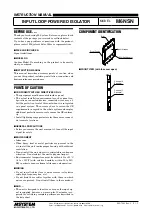
E6581531
A-19
1
1.5
Notes on the application
1.5.1 Motors
Keep the following in mind when using the VF-PS1 to drive a motor.
Caution
Mandatory
Use an inverter that conforms to the specifications of power supply and three-phase induction motor
being used. If the inverter being used does not conform to those specifications, not only will the
three-phase induction motor not rotate correctly, but it may cause serious accidents through
overheating and fire.
Comparisons with commercial power operation
The VF-PS1 Inverter employs the sinusoidal PWM system to supply the motor. This is why compared to operation
with a commercial power there will be a slight increase in motor temperature, noise and vibration. The main supply
voltage and current will also be distorted due to harmonic distortion while increase the line current.
Operation in the low-speed area
When running continuously at low speed in conjunction with a general purpose motor, there may be a decline in
that motor's cooling effect. If this happens, operate with the output decreased from rated load.
Adjusting the overload protection level
The VF-PS1 Inverter protects against overloads with its electronic thermal overload detection circuits. The
electronic thermal's reference current of the inverter must be adjusted in line with the rated current of the motor
being used in combination.
High-speed operation at and above 50Hz/60Hz (rated frequency)
Operating at frequencies greater than 50Hz/60Hz will increase noise and vibration. There is also a possibility that
such operation will exceed the motor's mechanical strength under these conditions and the bearing limits. You
should verify with the motor's manufacturer operating.
Method of lubricating load mechanisms
Operating an oil-lubricated reduction gear and gear motor in the low-speed areas will worsen the lubricating effect.
Check with the manufacturer to find out about operable speed range.
Low loads and low inertia loads
The motor may demonstrate instability such as abnormal vibrations or overcurrent trips at light loads of 50% or
under of the rated load, or when the load's moment of inertia is extremely small. If that happens reduce the carrier
frequency.
Occurrence of instability
Unstable phenomena may occur under the load and motor combinations shown below.
• Combined with a motor that exceeds applicable motor ratings recommended for the inverter
• Combined with special motors
To deal with the above lower the settings of inverter carrier frequency.
• Combined with couplings between load devices and motors with high backlash
In this case, set the S-pattern acceleration/deceleration function and adjust the response time inertial moment
setting during vector control or switch to V/f control (
RV
=
Q
).
• Combined with loads that have sharp fluctuations in rotation such as piston movements
In this case, adjust the response time inertial moment setting during vector control or switch to V/f control (
RV
=
Q
).
If it is operated in vector control mode (For torque control mode), only a motor whose capacity is same as inverter
standard or 1 ranking lower should applied.
Braking a motor when power supply is lost
A motor with its power cut off goes into freewheel, and does not stop immediately. To stop the motor quickly as
soon as the power is cut off install an auxiliary brake. There are different kinds of brake devices, both electrical and
mechanical. Select the brake that is best for the system.
















































